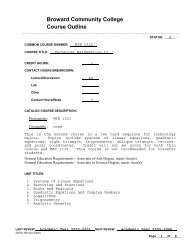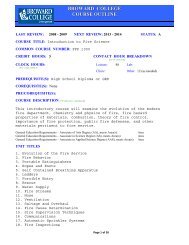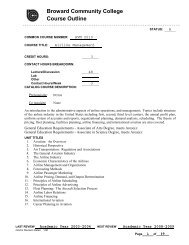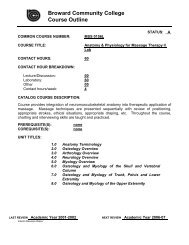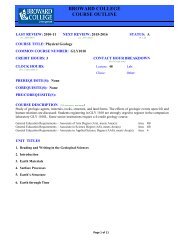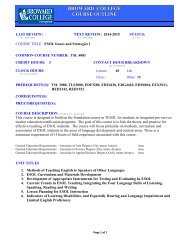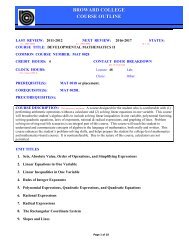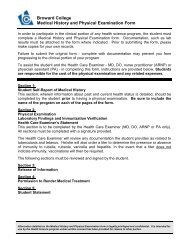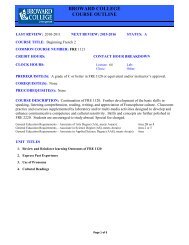MNA1161.pdf - Broward College
MNA1161.pdf - Broward College
MNA1161.pdf - Broward College
Create successful ePaper yourself
Turn your PDF publications into a flip-book with our unique Google optimized e-Paper software.
BROWARD COLLEGE<br />
COURSE OUTLINE<br />
LAST REVIEW: 2008 - 2009 NEXT REVIEW: 2013 - 2014 STATUS: A<br />
COURSE TITLE: Introduction to Customer Service<br />
COMMON COURSE NUMBER: MNA1161<br />
CREDIT HOURS: 3<br />
CONTACT HOUR BREAKDOWN<br />
(per 16 week term)<br />
CLOCK HOURS: Lecture: 48 Lab:<br />
(Voc. Course ONLY)<br />
Clinic:<br />
Other:<br />
PREREQUISITE(S): None<br />
COREQUISITE(S): None<br />
PRE/COREQUISITE(S):<br />
COURSE DESCRIPTION This course provides the student with the basic concepts and current trends in<br />
the customer service industry. Through actual case studies, the students analyze organizations that have<br />
implemented successful customer service strategies.<br />
UNIT TITLES<br />
1. Defining the Customer Service Economy<br />
2. Recognizing a Distinction for Excellence<br />
3. Defining a Customer Oriented Culture<br />
4. Developing a Model for a Quality Service System<br />
5. Implementing a Customer Oriented System<br />
6. Understanding the Duelism Theory<br />
7. Monitoring Quality Assurance<br />
8. Distinguishing Criteria for Success<br />
9. Providing Exceptional Customer Service<br />
10. The Art of Keeping the Customer<br />
Common Course No: MNA 1161 Page 1 of 11
BROWARD COLLEGE<br />
COURSE OUTLINE<br />
EVALUATION:<br />
Evaluation may include but is not limited to the following:<br />
Exams, Quizzes, Presentations, Portfolios, Discussions, Class Participation, Attendance, Projects, Co-ops, Practicum,<br />
Internships, Externships, and Research Reports.<br />
*** Complete the following only if course is seeking general education status ***<br />
GENERAL EDUCATION Competencies and Skills *:<br />
Please highlight in green font all Competencies/Skills from the list below that apply to this course. In the box to the right of the<br />
Competency/Skill, enter all specific learning outcome numbers (i.e. 1.1, 2.7, 5.12) that apply.<br />
1. Read with critical comprehension<br />
2. Speak and listen effectively<br />
3. Write clearly and coherently<br />
4. Think creatively, logically, critically, and reflectively<br />
(analyze, synthesize, apply, and evaluate)<br />
5. Demonstrate and apply literacy in its various forms:<br />
(highlight in green ALL that apply)<br />
( 1. technological, 2. informational, 3. mathematical,<br />
4. scientific, 5. cultural, 6. historical, 7. aesthetic and/or<br />
8. environmental )<br />
6. Apply problem solving techniques to real-world<br />
experiences<br />
7. Apply methods of scientific inquiry<br />
8. Demonstrate an understanding of the physical and<br />
biological environment and how it is impacted by<br />
human beings<br />
9. Demonstrate an understanding of and appreciation<br />
for human diversities and commonalities<br />
10. Collaborate with others to achieve common goals.<br />
11. Research, synthesize and produce original work<br />
12. Practice ethical behavior<br />
13. Demonstrate self-direction and self motivation<br />
14. Assume responsibility for and understand the impact<br />
of personal behaviors on self and society<br />
15. Contribute to the welfare of the community<br />
* General Education Competencies and Skills endorsed by ’05-’06 General Education Task Force<br />
Common Course No: MNA 1161 Page 2 of 11
BROWARD COLLEGE<br />
COURSE OUTLINE<br />
Common Course Number: MNA1161<br />
UNITS<br />
Unit 1: Defining the Customer Service Economy<br />
General Outcome:<br />
1.0 The student shall be able to describe the current trends in the customer service<br />
industry and importance of service delivery in the new service revolution.<br />
Specific Measurable Learning Outcomes:<br />
Upon successful completion of this unit, The student shall be able to:<br />
1.1 Describe the changes in the customer service economy.<br />
1.2 Define the customer service sector and distinguish its segments of the economy.<br />
1.3 Recognize the fall of the rational model.<br />
1.4 Identify methods for analyzing a changing society (content analysis).<br />
1.5 Compare characteristics of the new customer demands:<br />
1.5.1 Flexibility<br />
1.5.2 Efficiency<br />
1.5.3 Innovation<br />
1.6 Recognize the need to redefine service strategies in meeting customer demands.<br />
Common Course No: MNA 1161 Page 3 of 11
BROWARD COLLEGE<br />
COURSE OUTLINE<br />
Unit 2.<br />
Common Course Number: MNA1161<br />
Recognizing a Distinction for Excellence<br />
General Outcome:<br />
2.0 The student shall be able to identify the characteristics that determine customer<br />
service excellence in an organization.<br />
Specific Measurable Learning Outcomes:<br />
Upon successful completion of this unit, The student shall be able to:<br />
2.1 Define quality customer service.<br />
2.2 Identify the importance of leadership direction within a customer service<br />
organization.<br />
2.3 Recognize the "customer service imperative" role.<br />
2.4 Discuss customer service as a strategic tool for increasing sales and gaining a<br />
marketing edge.<br />
2.5 Recognize the customer service image as a managed perception.<br />
Page 4 of 12
BROWARD COLLEGE<br />
COURSE OUTLINE<br />
Unit 3.<br />
Defining a Customer Oriented Culture<br />
Common Course Number: MNA1161<br />
General Outcome:<br />
3.0 The student shall be able to explain the importance of a customer oriented culture.<br />
Specific Measurable Learning Outcomes:<br />
Upon successful completion of this unit, The student shall be able to:<br />
3.1 Identify and describe the importance of a customer oriented service culture within an<br />
organization.<br />
3.2 Relate the purpose of knowing customer orientation "niche" strategies.<br />
3.3 Explain the importance of developing powerful "customer service themes."<br />
3.4 Recognize "close to the customer" attributes.<br />
3.5 Explain the importance of implementing a bias for action model versus acceptance<br />
for ambiguity and paradox.<br />
3.6 Define value-added service strategies.<br />
Page 5 of 12
BROWARD COLLEGE<br />
COURSE OUTLINE<br />
Unit 4.<br />
Common Course Number: MNA1161<br />
Developing a Model for a Quality Service System<br />
General Outcome:<br />
4.0 The student shall be able to distinguish an effective model for delivering quality<br />
customer service.<br />
Specific Measurable Learning Outcomes:<br />
Upon successful completion of this unit, The student shall be able to:<br />
4.1 Relate the definition of a customer service strategy.<br />
4.2 Recognize the characteristics of a customer-driven organization.<br />
4.3 Understand the shift of deployment in the delivery system.<br />
4.4 Identify the steps in building the customer service system.<br />
4.5 Explain the importance of designing customer services in a systematic fashion.<br />
Page 6 of 12
BROWARD COLLEGE<br />
COURSE OUTLINE<br />
Unit 5.<br />
Common Course Number: MNA1161<br />
Implementing a Customer Oriented System<br />
General Outcome:<br />
5.0 The student shall be able to describe the importance of implementing a customer<br />
service system oriented to people.<br />
Specific Measurable Learning Outcomes:<br />
Upon successful completion of this unit, The student shall be able to:<br />
5.1 Describe how successful customer service organizations put the customer first.<br />
5.2 Recognize the importance of responding to the customer's expectations.<br />
5.3 Identify customer service strategies that demonstrate care and concern for the<br />
customer.<br />
5.4 Explain the importance of implementing customer-friendly systems.<br />
5.5 Understand the importance of hiring and developing qualified customer oriented<br />
front-line employees.<br />
5.6 Discuss the need for intensive training to keep employees close to the customer.<br />
Page 7 of 12
BROWARD COLLEGE<br />
COURSE OUTLINE<br />
Unit 6.<br />
Understanding the Dualism Theory<br />
Common Course Number: MNA1161<br />
General Outcome:<br />
6.0 The student shall be able to describe methods used to motivate employees in<br />
implementing the customer service strategy.<br />
Specific Measurable Learning Outcomes:<br />
Upon successful completion of this unit, The student shall be able to:<br />
6.1 Describe and discuss the theory that man is driven by an essential "duelism."<br />
6.2 Recognize the importance of psychological factors involved in employee motivation.<br />
6.3 Discuss the need to have authority at the level which delivers customer service and<br />
solves customer problems.<br />
6.4 Identify the importance of communication and feedback systems to gain employee<br />
involvement.<br />
6.5 Describe reward and recognition programs that encourage employee commitment.<br />
6.6 Explain the value in modeling high-energy, enthusiastic, and sincere attitudes.<br />
6.7 Identify the personnel responsible for serving the customer in a customer service<br />
organization.<br />
Page 8 of 12
BROWARD COLLEGE<br />
COURSE OUTLINE<br />
Unit 7.<br />
Monitoring Quality Assurance<br />
Common Course Number: MNA1161<br />
General Outcome:<br />
7.0 The student shall be able to discuss the importance of monitoring to assure quality<br />
customer service.<br />
Specific Measurable Learning Outcomes:<br />
Upon successful completion of this unit, The student shall be able to:<br />
7.1 Recognize the value and importance of measuring customer service quality.<br />
7.2 Describe methods for improving customer services through industrialization.<br />
7.3 Define the employee centered approach "the intelligent use of human intelligence."<br />
7.4 List the core elements of customer service quality and productivity assurance.<br />
7.5 Relate the need to define quality customer service objectives in order to measure<br />
quality, reliability of performance, and loyalty in relationships.<br />
7.6 Identify methods of measuring performance that determine if the system is fulfilling<br />
the customer service strategy.<br />
7.7 Distinguish the need for immediate feedback systems to determine customer service<br />
effectiveness.<br />
Page 9 of 12
BROWARD COLLEGE<br />
COURSE OUTLINE<br />
Unit 8.<br />
Distinguishing Criteria for Success<br />
Common Course Number: MNA1161<br />
General Outcome:<br />
8.0 The student shall be able to recognize the issues an organization must face in order to<br />
manage quality customer service.<br />
Specific Measurable Learning Outcomes:<br />
Upon successful completion of this unit, The student shall be able to:<br />
8.1 Identify three features outstanding customer service organizations have in common.<br />
8.2 Explain the customer service triangle approach to managing service.<br />
8.3 Recognize the customer's perception of service as crucial to customer service success.<br />
8.4 List and describe the five steps to success in a customer-driven organization.<br />
Page 10 of 12
BROWARD COLLEGE<br />
COURSE OUTLINE<br />
Unit 9.<br />
Common Course Number: MNA1161<br />
Providing Exceptional Customer Service<br />
General Outcome:<br />
9.0 The student shall be able to distinguish exceptional customer service delivery<br />
techniques.<br />
Specific Measurable Learning Outcomes:<br />
Upon successful completion of this unit, The student shall be able to:<br />
9.1 Explain the importance of responding to the customer's needs.<br />
9.2 Describe the "cycles of service" as experienced by the customer.<br />
9.3 Define the "moments of truth" and critical recovery period.<br />
9.4 Explain "mediocrity" and what results if left unmanaged.<br />
9.5 Discuss the importance of the "value-added" service attitude approach to customer<br />
service.<br />
9.6 Relate how a customer service deliverer should respond when the service system<br />
breaks down.<br />
Page 11 of 12
BROWARD COLLEGE<br />
COURSE OUTLINE<br />
Unit 10.<br />
The Art of Keeping the Customer<br />
Common Course Number: MNA1161<br />
General Outcome:<br />
10.0 The student shall be able to distinguish successful customer service organizations by<br />
investigating actual case studies.<br />
Specific Measurable Learning Outcomes:<br />
Upon successful completion of this unit, The student shall be able to:<br />
10.1 Identify specific strategies implemented by successful customer service<br />
organizations.<br />
10.2 Recognize how successful organizations measure customer satisfaction.<br />
10.3 Discuss ways successful organizations deliver outstanding customer service.<br />
10.4 Define obstacles organizations encounter in changing customer service attitudes.<br />
10.5 Relate ways successful organizations keep their customers.<br />
Page 12 of 12



